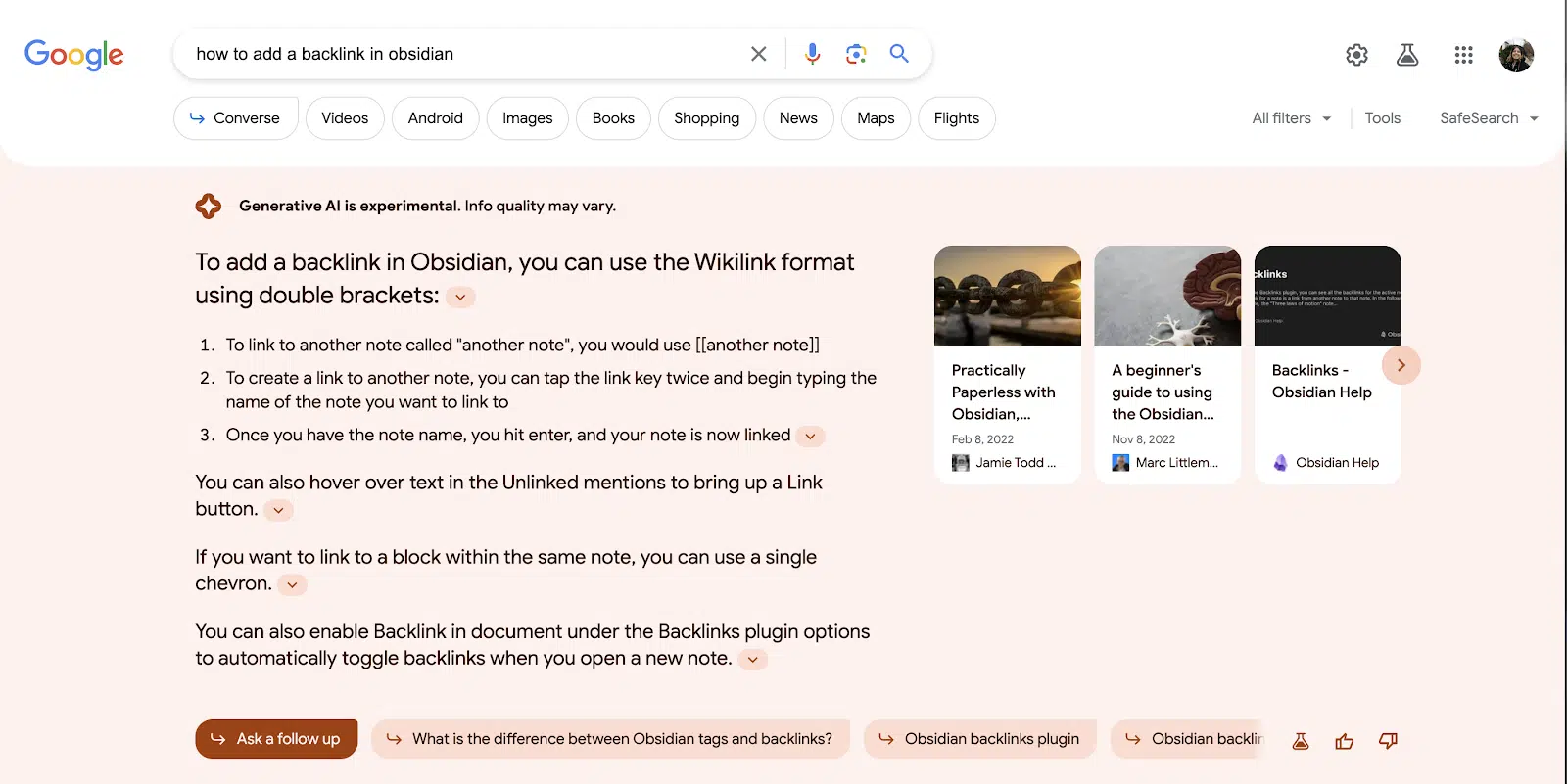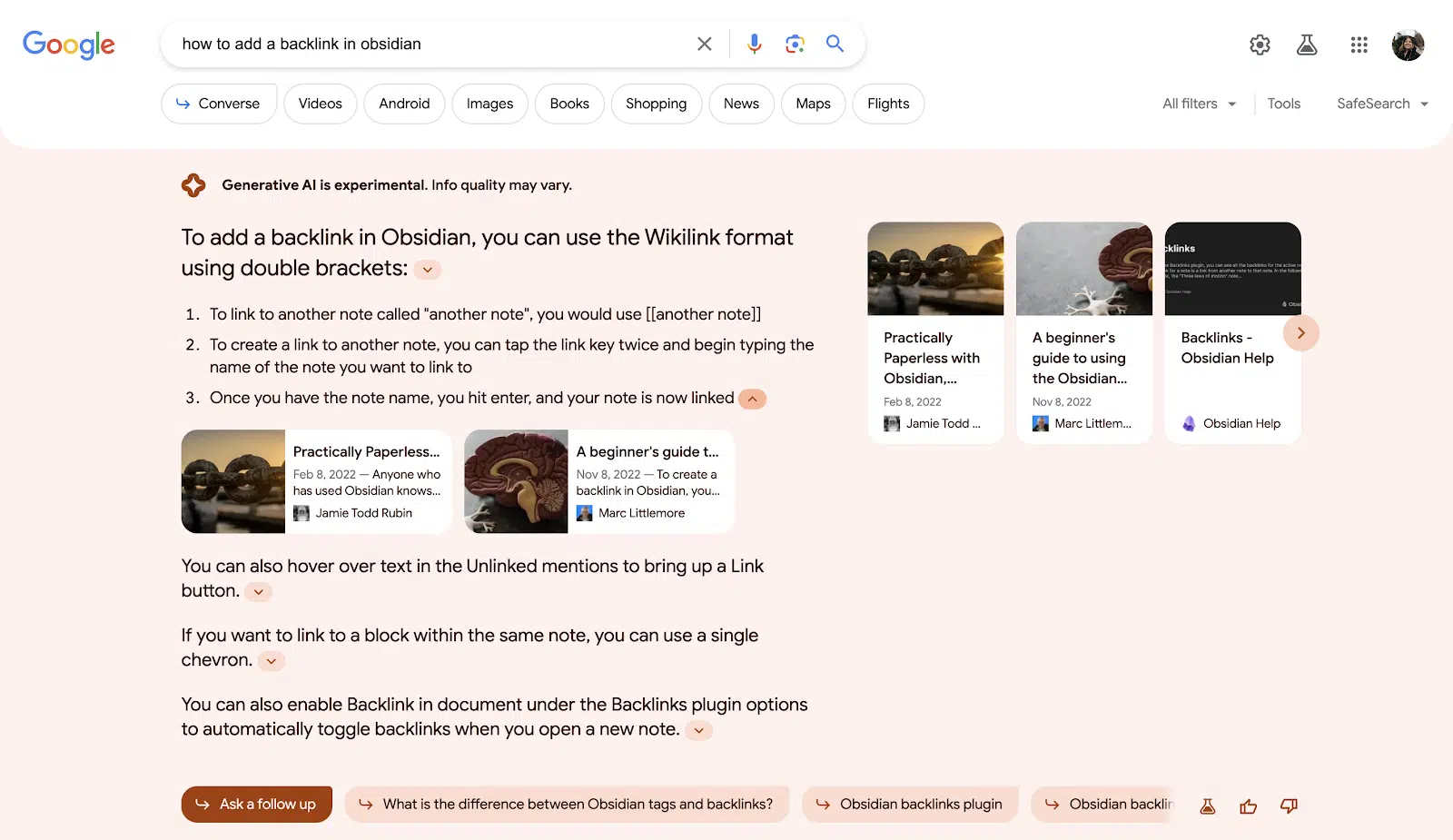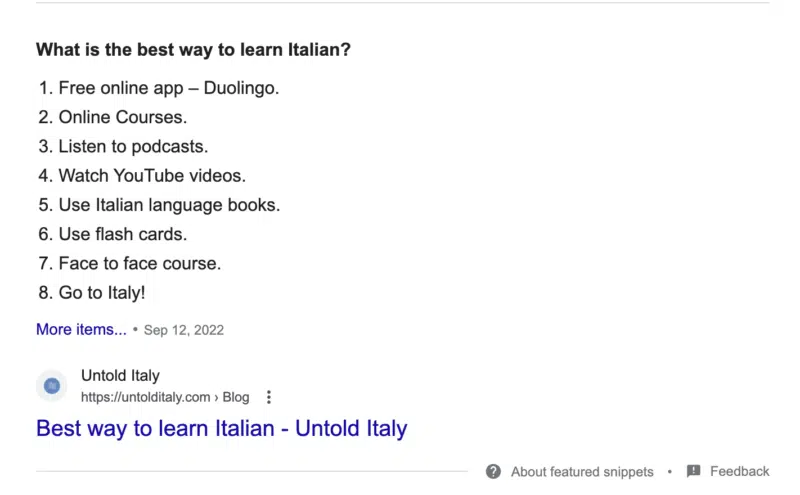A tale of two snippets: What link attribution in SGE tells us about search
More on the latest UI changes in SGE and how this new feature fits into the evolution of search engine results.
Are Google’s AI-generated summaries in their Search Generative Experience (SGE) interface unfairly stealing clicks from the website publishers who originally created those answers?
This is the question everyone in SEO and digital marketing has been asking for a couple of months now.
With Google’s latest update displaying links to SGE’s sources more prominently, now seems the best time to revisit that question.
Let’s stop talking about AI for a moment
But before we start, please do me a favor. for the next couple of sections, let’s set aside how the snippets in SGE are generated.
Why? Because I’ve noticed that too many discussions about SGE devolve into arguments about generative AI and large language models.
It’s a worthwhile discussion to have, and we should be talking about it. But we’re missing the point by reducing our thinking about SGE to the particular algorithm that’s currently powering it.
Fixating on this particular iteration of an algorithm that Google uses to generate previews of search results distracts us from asking much more interesting questions.
As SEOs, we should think about features in terms of the search experience itself and ask:
- What is the search page displaying?
- In what ways is the search page presenting that information?
- How do the structure and content of the search page impact those who create the content being displayed (website publishers) and those seeking answers to their search queries (users)?
- How do those impacts compare against alternative implementations of a search results page?
- Which of those implementations makes for the best search experience (whatever that might mean)?
We can’t ask any of those questions when we are getting stuck in the complexities of how Google’s generative AI model works.
So, for a few minutes, let’s pretend it doesn’t matter how Google generates the answers displayed in SGE.
Our discussion won’t depend on whether those answers are crafted by generative AI, a different algorithm, submitted by website owners, hand-written by a Googler stuck in some basement office, or magically cast into existence by a team of little green fairies.
Can you do that for me? Great!
Now, let’s talk about SGE.
SGE’s new link attribution
On Tuesday, Google introduced a new design to SGE that made links more visually prominent.
Previously, the default SGE interface didn’t show sources in an obvious way. Instead, users had to click on a button to see links explicitly within the text of that snippet:

As of Aug. 1, there is only one mode, which shows a clickable chevron at the end of each paragraph:

When you click on that chevron, you’ll see a dropdown with clickable links for webpages where SGE sourced its summary:

As you can probably tell, this new UI looks very similar to the expanded mode on SGE’s old interface.
However, I suspect this will be a major improvement for most users. I’m probably in the minority for having regularly clicked on that tiny expansion button.
Why do we care?
Even small design tweaks to how Google displays attribution are important to anybody creating and publishing content on the web.
After all, Google’s previous iteration of SGE received a lot of public criticism. Most notably, Avram Piltch from Tom’s Hardware wrote in early June:
- “Instead of highlighting links to content from expert humans, the ‘Search Generative Experience’ (SGE) uses an AI plagiarism engine that grabs facts and snippets of text from a variety of sites, cobbles them together (often word-for-word) and passes off the work as its creation.”
Many have already praised Google’s new UI as a significant improvement.
- SGE “is learning to give credit where it’s due,” says Android Police.
- 9to5Google hopes this design will end up “directing more traffic through to the sources.”
I even heard good things from one of the more vocal critics of SGE’s initial lack of attribution, Lily Ray. Ray, who serves as the Senior Director, SEO and Head of Organic Research at Amsive Digital, told me:
- “I’ve been very vocal since day one about the importance of Google incorporating links into SGE answers, just like Bing Chat has done from the start. I was excited (and relieved) today to see that Google took our concerns seriously and seems to be testing multiple layouts for incorporating links in SGE answers.”
Slow down: Is SGE actually a ‘plagiarism engine’?
But wait. What did Tom’s Hardware mean by “plagiarism” in the quote above?
Piltch’s description is genuinely fascinating.
Read this again, but apply every statement to Google’s pre-existing featured snippets:
- “…engine that grabs facts and snippets of text from a variety of sites, cobbles them together (often word-for-word) and passes off the work as its creation.”
The only real difference between SGE’s summaries and featured snippets is the number of links they include (and a lack of pretty colors):

You could say that the example above, like SGE, also “grabs facts and snippets of text” explicitly “word-for-word” from Untold Italy’s website.
So why is one interface treated as searching while the other as stealing?
I believe SGE includes quotes from websites functionally the same as the text displayed in featured snippets or most other rich results within Google’s SERP.
Danielle Stout Rohe, Sr. Data Program Manager, Content and SEO at Cox Automotive Inc., agrees. As she told me:
- “When SGE first came out, it felt like an expanded featured snippet (FS) to me. The only major difference was that the default view in SGE didn’t clearly indicate what text was tied to what site, but the other SGE view does.”
SGE feels like a natural development from previous SERP features.
- In 2007, Google wrote about meta descriptions that they “want snippets to accurately represent the web result.”
- In 2012, they introduced rich snippets guidelines to “provide even better summaries” to users.
- In 2014, they added “structured snippets” for additional data.
- In 2018, Danny Sullivan announced a relaunch of featured snippets, saying:
“We display featured snippets in search when we believe this format will help people more easily discover what they’re seeking, both from the description and when they click on the link to read the page itself. It’s especially helpful for those on mobile or searching by voice.”
Most of this language tracks pretty directly across all those developments, from 2007 to the 2023 test with SGE.
But I wasn’t there in those early days of SEO. Thankfully, I know someone who was.
So, I asked fellow marketer and my occasional collaborator Rand Fishkin (CEO of SparkToro; formerly Moz), who told me:
- “Even in the pre-2010 days, most SEOs I talked to had the sense that the “10-blue-links” era was fading (especially after the integration of things like Google Maps, weather, sports scores, etc. between 2006-2009). I never believed much in predicting the future, but I don’t think the rise of zero-click searches and instant answers would have been a huge surprise to anyone who watched the SERPs in those years.”
We can speculate how much SGE was influenced by the recent popularity of OpenAI’s ChatGPT. But I don’t think these features are simply Google’s attempt to capture industry hype.
SGE’s summaries are simply the newest form of “instant answers” in a long line of previous iterations.
Why were we afraid of featured snippets?
What do we fear when we accuse a search engine like Google of “stealing”?
One way to approach this problem is to look backward. How did we feel when featured snippets and their lengthy quotes first launched?
Featured snippets also caused a fair amount of anxiety. As Paul Shapiro, Head of Technical SEO at Shopify, explained to me:
- “When Google first introduced featured snippets, I was concerned about the potential rise of ‘zero-click’ searches, fearing that Google might retain all traffic on the SERP or within its own ecosystem.”
Shapiro’s fear makes a lot of sense. When we publish content online, we hope that users will find it. The whole premise of SEO is to help websites get found for relevant queries.
Ranking higher on the SERP is merely a way to increase a site’s exposure to more users, in the hopes that they’ll click through.
Even Google themselves agree. When describing the new link UI in an Aug. 2 update, they wrote:
“SGE is designed to be a jumping-off point for exploring helpful information on the web, with links to search results included alongside each AI overview.”
It’s completely fair to question whether we want a search engine “stealing” our clicks or reducing our CTRs. But that question is not unique to SGE. Our concern about losing clicks to SERP previews should also apply to other content previews that were introduced in the past.
When Google first announced rich snippets in a 2009 blog post, they described the feature as a way to increase the amount of clicks that websites would receive:
“It’s a simple change to the display of search results, yet our experiments have shown that users find the new data valuable—if they see useful and relevant information from the page, they are more likely to click through.”
Worried about losing clicks to SGE’s summaries? We also need to consider those worries’ place within the long history of search engines featuring samples of website content in other forms.
We could argue that a search engine is taking away readers by presenting featured snippets, rich cards, meta descriptions, ranking algorithms, or the very design of the SERP.
After all, webpages ranking higher on search results get more clicks than those ranked below.
Why don’t we wonder how “fair” it is for a search engine to decide which sites are more worthy of being featured?
Do ‘zero-click’ snippets really reduce traffic?
It’s easy to look at a search snippet and think that users won’t click on your site when they can simply get their answers inside the SERP itself.
But user behavior is much more complicated than that, and some users will still look at the usual “blue links” even with SGE.
For example, Rohe noted:
- “Other times, I still find myself scrolling the results. Old habits die hard? Or I think it is more of the fact that we still want choice if we can have it (at least I do).”
And in the years we’ve witnessed other iterations of Google embedding content directly within the SERP, our websites haven’t exactly collapsed. As Shapiro observed:
- “The impact hasn’t been as severe as I initially anticipated. Featured snippets continue to direct traffic to the originating website. While I acknowledge that Google might continue to cannibalize more traffic over time, I don’t believe that SGE represents a future of SEO that we should worry about, at least not in its current form.”
Yes, Google as a corporation has reason to keep users on their own search results page.
However, if all users abandon their search engine because it’s not helping them find relevant websites, then Google’s revenue would suffer.
At the end of the day, they have to keep providing a decent enough user experience and provide publishers with enough visitors to make Google worth indexing their sites on.
And, as far as I can tell, the visually distinct top featured snippet actually tends to increase CTR.
Websites ranking in the top spot get 74.5% more clicks than the ones ranking second, according to Backlinko.
In that case, wouldn’t featuring even more websites in that coveted “spot zero”, as SGE does, be even better for driving visitors to websites?
What makes a good search engine?
At the core of our unease with significant changes to the SERP is a much bigger question than their impact on CTR: what makes a search engine like Google’s “good”?
We might not know it, but we all make certain assumptions about search.
Whenever we discuss updates to SERP features, we’re wrestling with our understanding of what makes a “natural” UX when searching the web.
The main problem that Google is solving is not “how do we steal traffic from websites.”
It’s easy to hate a large corporation, but for those working on Google search, the main question is, “how can we help users determine if certain results are what they are looking for?”
From that perspective, contextual curation is extremely useful. SGE feels like features of certain academic and professional databases, such as EBSCOhost or Westlaw.
Especially when meta descriptions and titles for multiple sites might sound similar, getting a more detailed content preview can be extremely helpful in figuring out what content to click on.
However, in its current form, SGE is often tacked on above other rich SERP features:

Ray noticed the same concern in her experience:
- “SGE results are often highly redundant with the information we already had in other SERP features, like featured snippets, Top Stories and Google Maps. SGE often appears above or intertwined with these existing features, which can be a bit overwhelming, especially given that it takes a few seconds to load.”
I believe comparing the quality of results between SERP features is exactly the type of discussion we should have.
Many SEOs never get to it because we get stuck on a vision of scary AI coming to mess up everyone’s search experience.
But… were things even that good before?
Search wasn’t perfect – and neither was SEO
I’ll be honest – I was excited about SGE because I thought it could shake up SEO. And we need that. We need some more variety and randomness in our industry.
Perhaps we need the field of SEO to fundamentally change. Because as things stand now, many search results have become unusable for average internet users.
The Washington Post recently argued that Google is losing its relevance as the web’s main search engine, partly because certain website owners have manipulated their rankings too much.
And even from our perspective, many marketers aren’t actually excited to produce SEO content.
I’ve heard marketers say that they treat their search content as a drag, an obligation, a chore.
And others have speculated whether some SEOs might be ashamed of their own work.
We’re living with a dark legacy of SEO, having started as a field with a pretty bad reputation. As Fishkin recalled to me:
- “SEO had a terrible reputation in the business, marketing, and technology world for the first decade I practiced it. My goal was always to prove that SEO was a respectable, powerful marketing channel and a world filled with wonderful people practicing a valuable craft. For years, Google hated the SEO community and treated it as a cancer to be eradicated. It took a long time and a lot of relationship building, content marketing, and value contribution before that turned around.”
It’s hard to feel like our work is not valued by the very search engine that we’ve made into one of our key marketing channels.
So when Google pushes out significant and disruptive changes to the SERP, we feel uncomfortable.
We don’t want the rug pulled out from under us or our clients, all of that hard-earned traffic taken away overnight.
But my question to you is – how valid is SGE, particularly, as the object of that fear?
Yes, there are plenty of reasons to be unhappy with Google as a corporation or their particular product decisions around search. And I am not going to defend the existence of large tech monopolies.
But I also know that whether we argue about SGE or not, Google will not cease to be a gigantic corporation. Those kinds of changes are up to lawyers and regulators, not SEOs.
We are marketing professionals living in a world where Google is the main search engine – a world where most people still use Google to browse the web.
We can foam at the mouth, arguing that Google might be stealing our traffic with a slightly fancier snippet, or we can ask more interesting questions.
And perhaps some of those questions could even shape the web in a direction we would like, whether it’s Google releasing those features or not.
Contributing authors are invited to create content for Search Engine Land and are chosen for their expertise and contribution to the search community. Our contributors work under the oversight of the editorial staff and contributions are checked for quality and relevance to our readers. The opinions they express are their own.
Related stories